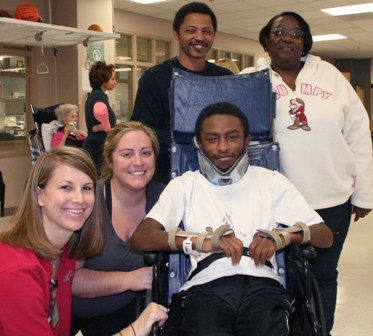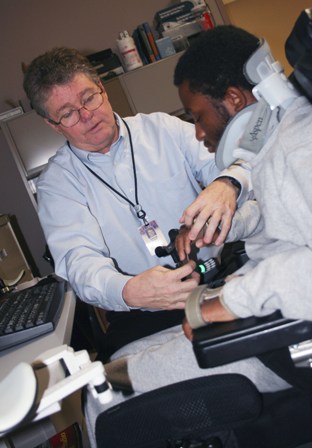As he left Methodist Rehabilitation Center on Jan. 11, Stevelyn Robinson of Winona had one plan in his playbook – to catch up with his friends at Montgomery High School’s next basketball game.
It would be different, of course, sitting courtside in a wheelchair rather than playing point guard for the Hornets. But “Pooda,” as his friends and family call him, isn’t one to dwell on life’s disappointments.
In the days since a Dec. 2 school bus crash sent his future careening in a new direction, the three-sport athlete has grown to appreciate the little things. Like brushing his own teeth. Holding a cup in his hands. Even rolling over in bed.
All were impossible in the first days after surgeons mended a fracture of his C-5 vertebra and delivered a bleak prognosis. Stevelyn was thought to have a “complete” spinal cord injury, meaning there was little chance for recovered ability below the injury site. The 17-year-old would likely be paralyzed from the chest down.
But his parents found reason for renewed hope after their son was transferred to Methodist Rehab in Jackson on Dec. 14. Stevelyn began using his arms and showing movement in his legs, and his injury was reclassified as incomplete.
It’s welcome news for a community that rallied around Stevie and Sheila Robinson as soon as they heard that both the couple’s children were among the seven students seriously injured in the crash. “It was packed in the waiting area of the hospital,” Stevie said. “Just about the whole community was there.”
Stevelyn and his 12-year-old sister, Jazalyn, were sitting near each other in the back of the bus when their driver pulled into the path of an empty log truck.
“I jumped up and grabbed my sister and the log truck hit the bus and I fell back,” Stevelyn said. The impact knocked the bus on its side, and the 5-foot tall, 123-pounder ended up at the bottom of a pile of kids.
Stevelyn didn’t realize the extent of his injuries. So when his parents arrived, he told them he was OK, and they hurried to Jazalyn, who was screaming in pain.
“We finally got her calmed down,” said his dad. “By the time we got back to Stevelyn, he was saying he couldn’t breathe. He didn’t realize he couldn’t move his legs until he got in the ambulance.”
Stevelyn was transported to Tyler Holmes Hospital in Winona, while Jazalyn was airlifted from the scene to the University of Mississippi Medical Center (UMMC) in Jackson. Soon, Stevelyn was also in a helicopter headed to UMMC.
Jazalyn had a skull fracture and underwent plastic surgery the day of the crash because of facial lacerations. She was able to go home a few days later. Stevelyn underwent surgery and spent a week in ICU. Five days later, he transferred to Methodist Rehab’s spinal cord injury program.
His dad said the family was inspired by stories of other Methodist program participants who had prevailed over their injuries. “We felt it was best for him to be in this setting, and I’m glad we took this choice. He is doing great,” he said.
Stevelyn’s therapists agree, but they add that his family played a big role in his progress. “He had really, really good family support,’ said physical therapist Ann Howard. “They were here all the time, motivating him and taking care of him.”
Stevelyn, in turn, impressed everyone in the therapy gym with his drive. “He came in with the best attitude and work ethic, bar none,” said occupational therapist Candace Raybon. “He doesn’t feel sorry for himself. He is always ready to work and get better.”
Both therapists say his hard work has paid off. “At first, he had to rely on his mom and dad to do most things,” Raybon said. Now he can feed himself, pull on a shirt, brush his teeth and sit by himself. And through outpatient therapy, he’ll continue to build on his strength and endurance and expand his abilities.
Stevelyn plans to be a computer engineer, and said he was encouraged by a visit to Methodist Rehab’s adaptive computing lab. There, he got a hands-on introduction to equipment and software that will make it easier to use his laptop at home.
While it’s too early to say whether he’ll walk again, no one doubts Stevelyn will give therapy his all. He has never been the kind to take the easy way out.
Sheila said she remembers worrying when her smaller than average son took up football. “Then I watched him take down kids twice his size, and I said: OK. He has always been a fighter,” she said.
And an encourager, too.
As he rolled out of Methodist Rehab’s sixth floor therapy gym for the last time, therapists asked him to offer some words of advice to another paralyzed teen who had just arrived.
“Work hard,” he said with a smile. “And don’t ever give up.”


